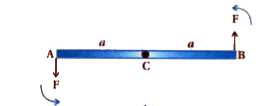Can a body will remain in partial equilibrium? Explain with illustration. Solution in Gujrati
A body may be in partial equilibrium, means it may be in translational equilibrium and not in rotational equilibrium, or it may be in rotational equilibrium are not in translational equilibrium.

Consider a light rod of negligible mass AB at the its two ends of which two parallel forces both equal in magnitdue are applied perpendicular to the rod as shown in above figure.
C be the midpoint of AB.
∴CA=CB=a assumed.
The moment of the forces at A and B will both be equal in magnitude (aF), but opposite in sense as shown. The net moment on the rod will be zero. The system will be in rotational equilibrium, but it will not be in translational equilibrium : ∑→F≠0

Now consider a light rod of negligible mass and length 2a. Its two ends A and B of which two equal and opposite forces →F applied perpendicuarlto the rod. C be the midpoint of AB.
∴AC=BC=a
Hence, both the torque on the rod in the same direction, cause anti-clockwise rotation of the rod.
So, the total force on the body is zero, so the body is in translational equilibrium, but it is not in rotational equilibrium due to torque.
If rod is fixed at C, then it undergoes pure rotational motion.
Topper's Solved these Questions
- SYSTEMS OF PARTICLES AND ROTATIONAL MOTIONBOOK - KUMAR PRAKASHANCHAPTER - SYSTEMS OF PARTICLES AND ROTATIONAL MOTIONEXERCISE - SECTION-A HOTS
3 Videos
- SYSTEMS OF PARTICLES AND ROTATIONAL MOTIONBOOK - KUMAR PRAKASHANCHAPTER - SYSTEMS OF PARTICLES AND ROTATIONAL MOTIONEXERCISE - SECTION-A (TRY YOURSELF (VSQs))
94 Videos
- QUESTIONS ASKED IN JEE - 2020 BOOK - KUMAR PRAKASHANCHAPTER - QUESTIONS ASKED IN JEE - 2020 EXERCISE - Question
16 Videos
- THERMAL PROPERTIES OF MATTERBOOK - KUMAR PRAKASHANCHAPTER - THERMAL PROPERTIES OF MATTEREXERCISE - Question Paper (Section - D) (Answer following in brief :) Each carry 4 marks
1 Videos
Similar Questions
What is torque? Explain the torque acting on a particle.
View SolutionWhat is a rigid body ? Explain the differences between rigid body and solid body.
View SolutionA non-isotropic solid metal cube has coefficient of linear expansion as 5×10−5/∘C along the x-axis and 5×10−6/∘C along y-axis and z-axis. If the coefficient of volumetric expansion of the solid is n×10−6/∘C then the value of n is....
View SolutionIn an experiment on the specific heat of a metal, a 0.20 kg block of the metal at 150∘C is dropped in a copper calorimeter (of water equivalent 0.025 kg) containing 150 cm3 of water at 27∘C. The final temperature is 40∘C. Compute the specific heat of the metal. If heat losses to the surroundings are not negligible, is your answer greater or smaller than the actual value for specific heat of the metal ?
View SolutionIf the displacement of a body is zero is the distance covered by it necessarily zero ? Explain with suitable illustration.
View SolutionBriefly explain equilibrium of a rigid body. When is a body said to be in partial equilibrium ?
View SolutionA rigid body is said to be in partial equilibrium, when it is in
View SolutionExplain the state of equilibrium based on the following illustration. See-saw
View SolutionExplain the state of equilibrium based on the following illustration.
Tug of war
View SolutionCan a body in linear motion be in equilibrium.
View Solutionएक दृढ़ पिण्ड आंशिक साम्य में कहा जाता है, जब वह होता है-
View SolutionCan a body in free fall be in equilibrium ?Explain?
View SolutionA body remain in equilibrium at which depth of liquid ?
View SolutionA rigid body will be in equilibrium if both the ______ and _______ of the body remain constant with time.
View SolutionExplain with illustration the pure translation and combination of translation and rotation motion of rigid body.
View Solution
